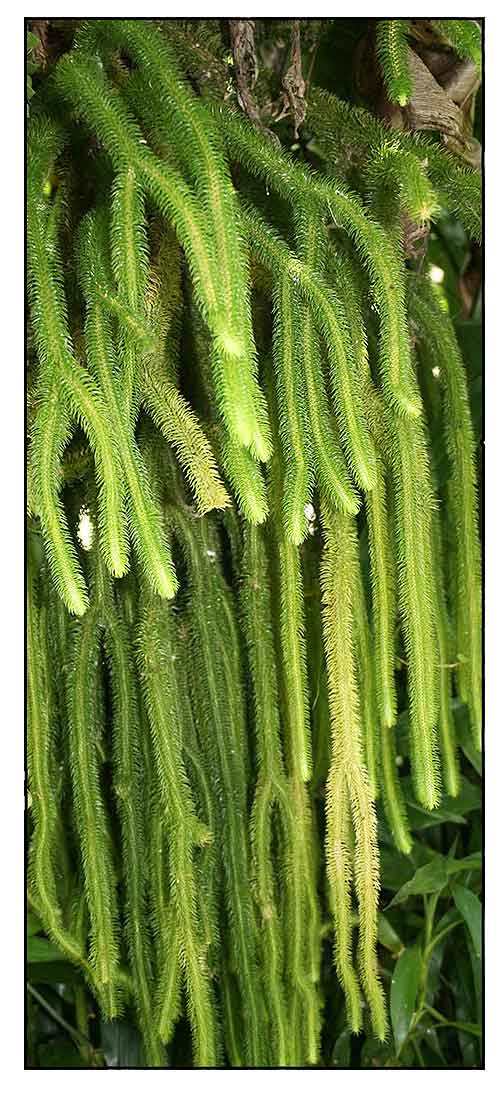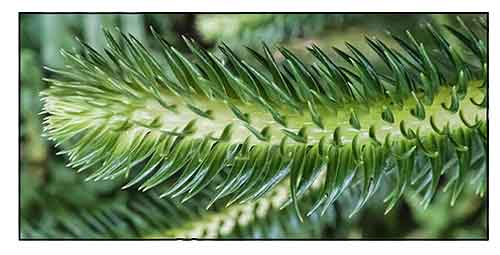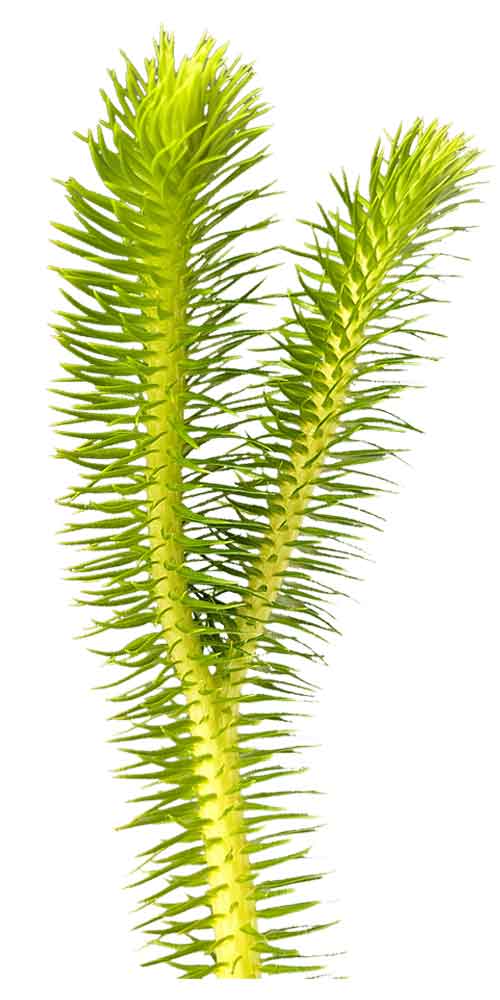 Gen info Gen info
- Lycopodiaceae are an old family of vascular plants, including all of the core clubmosses and firmosses, comprising 16 accepted genera and about 400 known species. "Wolf foot" is a common name for the family due to the resemblance of either the roots or branch tips to a wolf's paw. (11)
-
Huperzia is a genus of lycophyte plants, called firmosses or fir clubmosses (gemma fir-mosses by the Flora of North America). The genus was originally included in the related genus Lycopodium, from which it differs with its undifferentiated sporangial leave, and the sporangia not formed into apical cones. (2)
- As per PPG I classification, there were 25 species in the genus Huperzia. As of June 2024, World Ferns listed 62 species, noting that "many species still need transfer into other split genera". (2)
- The genus Huperzia was created by Johann Jakob Berhardi in 1801, who separated Huperzia from Lycopodium. (2)
Botany
• Lycophytes, large, epiphytic. Stems caespitose, robust, mature branches pendulous, 1 to several times forked, 25-100 cm, main stems 3-7 mm, stem together with leaves 2.5-3 cm wide at middle. Trophophylls lustrous, lanceolate, attached at right angles or slightly angled upward, 1.1-1.5 cm × 1-2 mm, thinly leathery, midrib distinct, base cuneate, decurrent, sessile, margin entire, apex acute. Strobili terminal on branches, slightly thinner than sterile part, columniform. Sporophylls densely arranged, ovate-lanceolate, 8-15 × ca. 0.9 mm, midrib distinct, base cuneate, margin entire, apex acute. Sporangia yellowish, reniform, vertically bisected. (Flora of China)
• Growth form: A type of fir clubmoss, one of the oldest "living fossils" of fern-allies, with fossils dating back to the Carboniferous period (~360 million years ago). Herbaceous with creeping rhizomes, arching to 20cm height and trailing up to 75cm length. Foliage: Fronds trailing, tufted, arched or nodding towards tip, bifurcating (dividing into 2) as they lengthen. Stems thin (4mm across), brownish when older. Frondlets pale to yellowish green, narrowly-linear and bristle-like, whorled at 60-90° along stem axis. Bulblets (gemmae) formed at base of upper fronds during end of each annual growth cycle. (3)
 Distribution Distribution
- Native to the Philippines.
- Also native to Andaman Is., Assam, Bangladesh, Borneo, Cambodia, Caroline Is., China South-Central, China Southeast, Comoros, Cook Is., East Himalaya, Fiji, India, Jawa, Laos, Lesser Sunda Is., Madagascar, Malaya, Maluku, Mauritius, Myanmar, Nepal, New Caledonia, Queensland, Réunion, Samoa, Seychelles, Society Is., Solomon Is., Sri Lanka, Sulawesi, Sumatera, Taiwan, Thailand, Tibet, Tonga, Tubuai Is., Vanuatu, Vietnam. (1)
Constituents
- Study of Huperzia squarrosa isolated six Lycopodium alkaloids, named: lycosquarosine A (1), acetylaposerratinine (2), huperzine A (3), huperzine B (4), 8α-hydrophlemariurine B (5), and huperzinine (6). (see study below) (6)
Properties
- Studies have suggested antioxidant, neuroprotective, acetylcholinesterase inhibitory, anti-Alzheimer's properties.
Parts used
Whole plant, spores. twigs.
 Uses Uses
Edibility
- No report found on edibility.
Folkloric
- No reported folkloric medicinal use in the Philippines.
- In Manipur, India, plant extract mixed with honey and taken as a health tonic by women over 40 years to cure infertility and frigidity problems. Sometimes, it is mixed in equal proportions with extracts of Panax ginseng, Allium sativum, and Withania somnifera to increase sexual urge and stamina and to cure impotency. (9)
- Twigs harvested during winter are sun-dried and finely powdered and taken as supplementary tonic to boost memory, and cure epilepsy and sleeping disorders. In the past, the general public was prohibited from consuming leishang by tribal heads/kings (khulakpa) for fear it may enhance the thinking and intelligence of the people. (9)
- Whole plant used for gastropathy and rheumatism.
- Sporophylls with mature spores and sporangia are powdered for year-long storage, and dusted as antiseptics on cuts, skin ruptures.
(9)
Others
- Theater effects: The spores burn quickly and brightly with little heat, and are were used as flash powder for theater effects and cameras in the 19th century. (4)
- Rituals: In Manipur, India, used in ritual ceremonies and worshiping of forefathers. (9)
Studies
• Neuroprotective / Acetylcholinesterase Inhibitory Activity / Attenuation of Scopolamine-Induced Cognitive Impairment / Antioxidant: Study of evaluated the in vitro antioxidant, AChE inhibitory activities of H. squarrosa fractions and neuroprotective effects of EtOAc fraction on scopolamine-induced cognitive impairment in mice. The EtOAc fraction showed strongest antioxidant activity with IC50 of 9.35 µg/mL and AChE inhibitory activity with IC50 of 23.44 µg/mL in a concentration-dependent manner. Scopolamine induced effects of significantly increased escape latency time, reduced number of crossings, and swimming time in target quadrant were reversed by the EtOAc fractions, which also significantly increased levels of acetylcholine in the brain and significantly decreased oxidative stress in mice. Results suggest the EtOAc fraction of H. squarrosa extract exhibited strong neuroprotective effect on cognitive impairment, and may have potential for treatment of Alzheimer's disease. (5)
• Lycopodium Alkaloids / Inhibitors of AChE activity: Study of Huperzia squarrosa isolated six Lycopodium alkaloids, named: lycosquarosine A (1), acetylaposerratinine (2), huperzine A (3), huperzine B (4), 8α-hydrophlemariurine B (5), and huperzinine (6). Compound 1, lycosquarosine A, completely inhibited AChE activity in a dose dependent manner with IC50 of 54.3 µg/mL, while acetylaposerratinine (2) showed stronger inhibitory activity than 1 with IC50 of 15.2 µg/mL. Study suggests alkaloids may be a potent source of AChE inhibitors. (6)
• Alkaloids Inhibitors of AChE activity: Study of Thai and Philippine Huperzia squarrosa isolated two new Lycopodium alkaloids, squarrosine A (1) and pyrrolhyperzine A (2), and a known alkaloid (R)-2-piperidineacetic acid (5). The new compounds exhibited moderate acetycholinesterase inhibitory activities. (7)
• Molecular Docking and Molecular Dynamics Study / Potential for Treating Alzheimer's Disease: Alzheimer's disease (AD) is a lingering progressive neurodegenerative disorder that causes loss of cognitive function. The enzymes Acetylcholinesterase (AChE), Butyrylcholinesterase *BuChE), Monoamine oxidase A (MAO A), Beta-secretase cleavage enzyme (BACE 1) and N-methyl-D-aspartate (NMDA) receptors play an important role in the pathogenesis of AD. Enzyme inhibition is an effective method to treat AD. Study evaluated in silico inhibitory effects of AChE, BuChE, MAO A, BACE 1 and NMDA enzyme of Huperzia squarrosa’s compounds. Review of previous publications reveal 15 compounds of which hyperzine B, huperzinine, lycoposerramine U N-oxide, 12-epilycodine N-oxide showed strong inhibition of five targets for AD treatment viz., AChE, BuChE, MAO A, BACE 1 and NMDA. Lipinski rule of five and ADMET showed four of the compounds have drug-likeness properties, good absorption ability and cross the blood-brain-barrier, with highest potential for treatment of AD. Molecular docking also showed hyperizine B and huperzinine have stability of the docking pose with NMDA target. (8)
Availability
- Wild-crafted. |

![]()



 Gen info
Gen info

